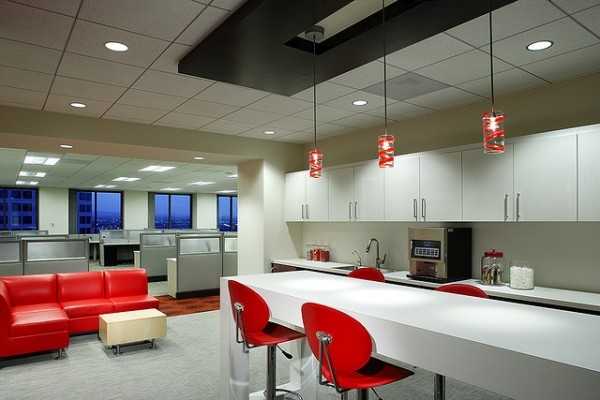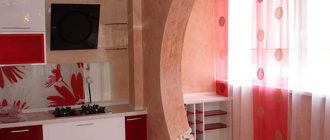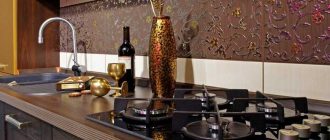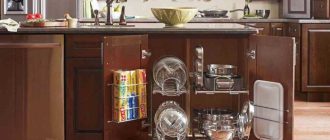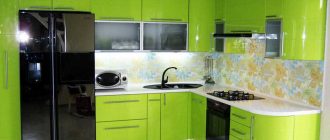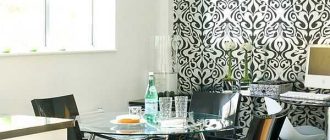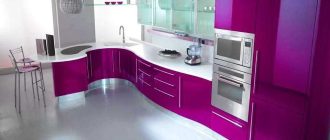Decorating a kitchen is a difficult task. It should be practical, convenient, beautiful and preferably not very expensive. And one of the problems that have to solve – to choose what ceiling to make in the kitchen that it was easy to use, served for a long time and was still attractive.
Съдържание на статията
Requirements for kitchen ceilings
Kitchen – a room with difficult operating conditions. Increased humidity, abundance of pollutants, in apartments – a high probability of waterlogging. All this imposes certain requirements for finishing materials. In particular, the ceiling in the kitchen should have the following characteristics:
In addition to all this, there is another wish – it is not bad if the ceiling in the kitchen makes it possible to hide the engineering networks (ventilation, wiring) and the shortcomings of the slab.
Unfortunately, even with the current abundance of finishing materials, the whole set of requirements is not combined in any of them, but there are very good options.
Whitewashing, painting
Some time ago, any ceilings we had whitewashed. Because this type of finish costs a penny, the material is widespread, the process of whitewashing itself was not difficult and almost everyone whitewashed ceilings themselves.
Another plus of this method of finishing the flow in the kitchen is the ability of lime to regulate humidity. With an excess of moisture in the air, it absorbs it, with a lack of it gives it away. For the kitchen – an excellent quality. This is where the pluses end.
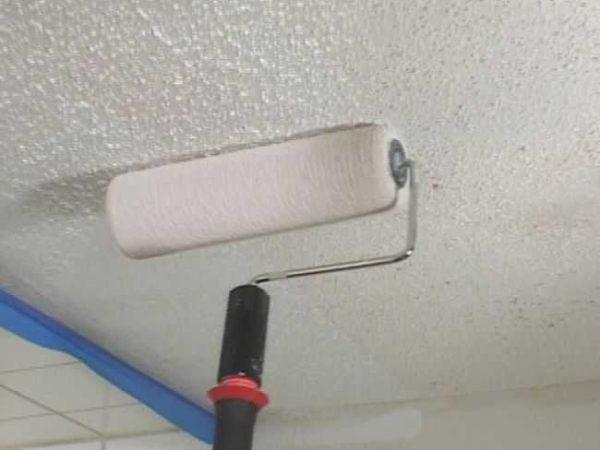
The disadvantages of whitewashing the ceiling are also significant. The first disadvantage is not the most attractive look. The second – the surface is porous, except moisture, it absorbs odors. Caught on the surface drops of grease or coloring liquids are absorbed into the material, after which nothing and nothing can not be removed. They are only painted over with a new layer or two of lime. It is for these reasons that now whitewash in the kitchen is increasingly rare.
Painting the ceiling in the kitchen is a modern replacement for whitewash. For these purposes, water emulsion paints with increased washability are most often used. With normal preparation of the ceiling, the view is at least normal. Operational properties are also improved – the painted ceiling in the kitchen can be washed several times using liquid detergents.
The main disadvantage of this option is the need for careful preparation of the surface for painting. To painted shelf looked good, it must be even, without imperfections. Level it first with plaster, then, in several layers, putty. The process is not easy, long, costly.
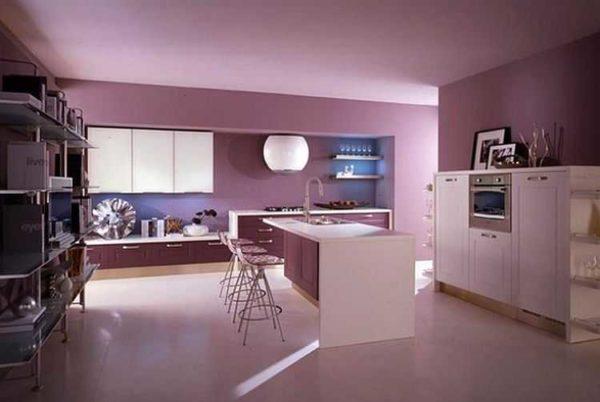
To make the preparation of the ceiling for painting a little easier helps wallpaper under painting. The ceiling also needs to be leveled, but not to such an extent as under the application of paint. For these purposes, there are special glass wallpaper, fleezelin, paper. The most durable – from fiberglass. They can be repainted up to 20 res. The least of all serve paper. They can withstand 2-3 repaints. Fleece – not a bad option both in quality and price. Also please with a rich choice of ornaments (if you want, of course).
Another disadvantage of painted ceilings – when leaking there are divots, which can only be painted over. Paint only the damaged part is rarely possible – you get different shades. You have to paint the whole ceiling.
Ceiling tiles
If you do not know the ceiling to make in the kitchen to be inexpensive and fast, consider a tile of Styrofoam or polystyrene. This method is nowhere near as popular as it was 10 years ago, but it is still used when there is a lack of money and/or time for other types of finishes.
Ceiling tiles in the kitchen are not a bad option. It is washable, and you can use a brush and liquid non-abrasive detergents. Ceiling tiles are glued on a special glue. The base is preferably flat, without sharp drops, but the ideal surface is not required. Installation takes a few hours, and immediately get a ready-to-use ceiling.
Disadvantages are few. The first – not everyone likes the appearance. Here you can agree or not – a matter of taste. The material is not chic, but the result is quite decent. Especially if you need an inexpensive way of finishing.
The second disadvantage – unnatural material. With this you can not argue, but the material used – polystyrene – chemically neutral and in a normal state does not emit any substances. Neither harmful nor useful. And this is also not bad.
Plasterboard
If you can make the ceiling in the kitchen lowering it by a few centimeters, consider the option of a suspended ceiling from plasterboard. This method of finishing the ceiling is good because you can make multi-level designs that completely cover the slab. In the gap between the main and false ceiling can be laid communications – vertkoroba, wiring.
The design of the ceiling allows you to install spotlights, choosing the place of their placement according to your taste, which makes the lighting in the kitchen more functional. The result can be very beautiful. Another positive point is that drywall is made of natural materials – it is two sheets of cardboard and a layer of gypsum between them.
The installation of a plasterboard ceiling is a difficult task. First, the frame is assembled from the rails, then it is covered with plasterboard, then putty and painted. The positive point is that plasterboard puttying is several times easier to level the base ceiling: the surface is initially flat, it is necessary to fix only the joints, and then, a thin layer of putty, cover the entire surface.
The disadvantage of the plasterboard ceiling in the kitchen is the complexity of care. Even if you use moisture-resistant water-emulsion paint, the surface will remain rough. The pores are clogged with soot, dust mixed with grease. It is not easy to remove this plaque. Another disadvantage – drywall reacts badly to water. If you use a moisture-resistant material, increased humidity, it will not be afraid, but with flooding from above, most likely everything will have to be redone.
Stretch ceiling
Stretch ceilings in the kitchen – not a bad choice. In any case – beautiful and modern. Although their device will again need to “take away” some volume: they are mounted at some distance from the ceiling. As in the case of plasterboard ceilings, stretch ceilings also allow you to hide the base ceiling and utilities. Spotlights can also be used for lighting, but of a different design.
Stretch ceilings come in film (their PVC film) and fabric. For the kitchen it is worth choosing film ones. They are smooth, which is easier to maintain, can be glossy, which makes the room brighter and adds volume. If you decide to make a stretch ceiling in the kitchen from PVC film, an additional bonus will be protection from waterlogging, since the film is completely waterproof. If you are flooded by neighbors from above, the water will collect like in a bag. It will have to be carefully poured out, after which the material will take its normal size.
The disadvantage of the film ceiling – the chemical origin and the ability to change the size of the sharp temperature change. The film can wrinkle, sag, etc. These suffer not the most high-quality cloths, but such a phenomenon is present. Another significant disadvantage – if you hit the film ceiling with a sharp object, the hole will be very large. The material is strongly stretched, because of which the slightest puncture turns into a huge hole. This disadvantage is deprived of fabric tensioned streams, but they are more loose in structure, it is more difficult to care for them, they are water permeable. But the hole made accidentally does not increase.
To the disadvantages should also include a high price and complexity of installation, although if desired, you can cope independently. If the installation of a film ceiling requires a heat gun or its substitute (to warm up the canvas), then for a fabric ceiling nothing is needed.
Plastic panels
If you are looking for what ceiling to make in the kitchen to be inexpensive and it is easy to wash – your choice of plastic panels. This material costs very little, you can wash it with a cloth using liquid detergents. The surface is usually smooth, everything is easily washed.
Plastic panels on the ceiling in the kitchen is mounted quickly and simply. On the perimeter, a starting skirting board is attached, and the panels cut to size are inserted into it. It also takes away a few centimeters of height and makes it possible to hide communications, you can use spotlights. An additional plus is the high repairability. If something happened to one or more slats, they can be removed, install in their place whole.
Also, this type of ceiling finish allows you to quickly get to the base ceiling or those systems that it hides. This is a useful property.
Disadvantages – not the best look and fragility of the panels. But the ceiling is usually a small load, so that serve plastic ceiling panels until the owners do not want something else. Another disadvantage – unnatural material, which when burning emits harmful substances.
Suspended ceiling armstrong
If you find out what kind of ceiling to make in the kitchen about this type is rarely remembered. Armstrong is more often used in offices, retail halls, production facilities, but in houses and apartments, it also shows itself well. It is inexpensive, easy to install, made of natural materials, has a high maintainability.
Suspended ceiling Armstrong is a system of profiles arranged in the form of squares. In the squares are inserted plates, which form the plane of the ceiling. The tiles are simply placed on the profiles and are not fixed in any way. It is convenient: you can easily change damaged plates, there is always access to the ceiling space.
The disadvantage of the system – takes away the height of the room, the boards are afraid of water (they are pressed and colored paper). And the traditional disadvantage for inexpensive ways of finishing the ceiling in the kitchen – not a very cozy look, although not everyone will agree with this.
Only the profiles can be washed, the plates can not. But they can be repainted or replaced with new ones – the cost is small, the replacement process will take an hour or two (taking into account trimming). In general, not a bad budget option for ceiling repair.

